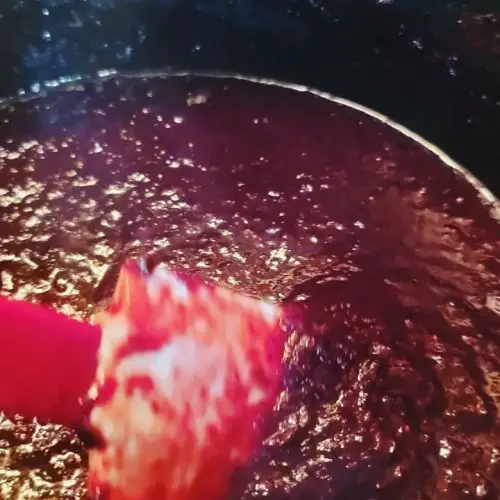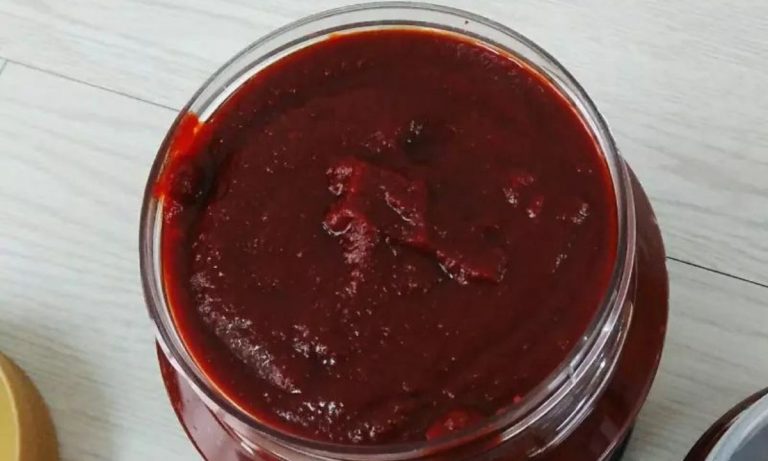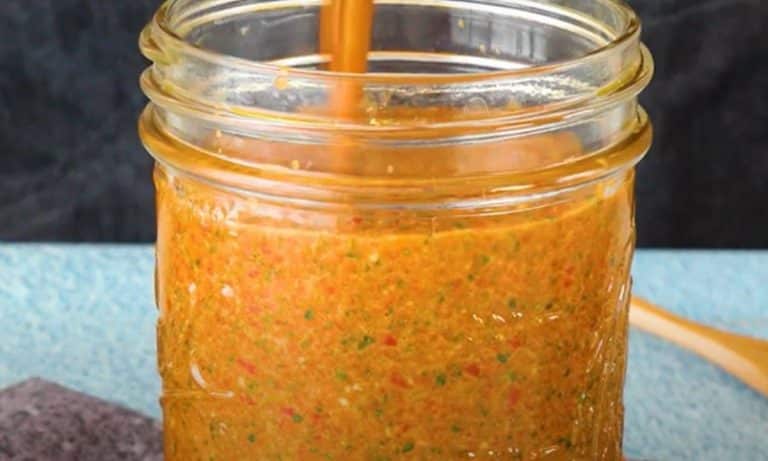Wojapi Sauce Recipe
Native Americans make wojapi sauce from mashed fruit and cornstarch or flour. Depending on the recipe and area, the sauce is sweetened with honey or sugar and flavored with herbs or spices.
Wojapi sauce can be used to top ice cream, pancakes, or other sweets, as well as fry bread and Indian pudding. Chokecherries, blueberries, raspberries, and strawberries make wojapi sauce.
I’ll walk you through making wojapi sauce at home in this post, along with some FAQs. Put on your apron and snag some fresh berries, let’s cook!
Wojapi Sauce Ingredients
- 2 cups fresh berries (chokecherries, blueberries, raspberries, or strawberries)
- 1/2 cup water
- 2 tablespoons cornstarch or flour
- 2 tablespoons honey or sugar (optional)
- 1/2 teaspoon cinnamon (optional)
- pinch of salt
How To Make Wojapi Sauce
Step 1: Prepare the Berries
The first step in making wojapi sauce is to prepare your berries. You can use any kind of fresh berries you like, but some of the most popular choices include chokecherries, blueberries, raspberries, and strawberries.
To prepare the berries, rinse them thoroughly under cold water to remove any dirt or debris. Then, place the berries in a medium saucepan and add 1/2 cup of water. If you are using chokecherries, you may need to remove the pits before adding them to the saucepan.
Step 2: Cook the Berries
Once your berries are prepared, it’s time to cook them. Place the saucepan over medium heat and bring the berries and water to a simmer. Use a potato masher or fork to mash the berries until they are broken down and most of the liquid has been released.
Continue to simmer the berries for 10-15 minutes, stirring occasionally, until they have cooked down and become soft and juicy.
Step 3: Thicken the Sauce
Now it’s time to thicken the sauce. In a small bowl, whisk together 2 tablespoons of cornstarch or flour with 1/4 cup of cold water. This will create a slurry that you will use to thicken the sauce.
Slowly pour the slurry into the saucepan with the cooked berries, stirring constantly to prevent lumps from forming. Continue to cook the sauce over medium heat, stirring frequently, until it thickens and becomes glossy.
If you want a sweeter sauce, you can add 2 tablespoons of honey or sugar at this point, along with a pinch of salt and 1/2 teaspoon of cinnamon if desired. Stir well to combine.
Step 4: Strain the Sauce (Optional)
If you prefer a smoother sauce without any berry bits, you can strain the wojapi sauce through a fine-mesh sieve or cheesecloth. This will remove any solids and create a smoother, more uniform sauce.
To strain the sauce, place the sieve or cheesecloth over a bowl and pour the sauce through it. Use a spoon or spatula to press the solids against the sieve or cheesecloth to extract as much liquid as possible.
Step 5: Serve and Enjoy!
Your wojapi sauce is now ready to serve! You can use it as a topping for pancakes, ice cream, or other desserts, or as a glaze for meat dishes such as grilled chicken or pork chops.
Store any leftover wojapi sauce in an airtight container in the refrigerator for up to 1 week. You can reheat the sauce gently in a saucepan over low heat or in the microwave before serving.
How To Use Wojapi Sauce
Wojapi sauce is a unique topping for crepes and waffles. It adds sweetness and fruitiness to breakfast.
It can top ice cream, cheesecake, and other sweets. Its sweet, fruity taste complements creamy sweets.
Use in savory meals like barbecue sauce or meat glazes. Its sweet and tangy taste complements grilled poultry and pork.
Wojapi sauce adds taste to cocktails and non-alcoholic drinks. It complements citrus-based drinks.
This condiment can marinate meats and veggies. Its sweet and spicy taste tenderizes and flavors food while cooking.
Wojapi Sauce Variations
Chokecherries are used in the original wojapi sauce recipe, but you can substitute any other variety of berries you like. I have some suggestions for you:
- Blueberry Wojapi Sauce: Substitute blueberries for chokecherries in the recipe. This will result in a sweeter sauce with a milder flavor.
- Raspberry Wojapi Sauce: Use raspberries instead of chokecherries for a tangy and slightly tart sauce.
- Mixed Berry Wojapi Sauce: Combine a variety of berries, such as strawberries, blackberries, and raspberries, to create a mixed berry wojapi sauce. This will give you a range of flavors and beautiful colors.
- Spiced Wojapi Sauce: Add cinnamon, nutmeg, or other warm spices to the sauce for a unique flavor twist. This works particularly well with apple or pear-based wojapi sauces.
- Savory Wojapi Sauce: Experiment with adding savory ingredients like ginger, garlic, or soy sauce to the sauce for a more complex flavor profile. This works well when using the sauce as a glaze or marinade for meats.
How To Store
Refrigerate wojapi sauce for two weeks. After cooling to room temperature, keep the sauce in an airtight container. Label and refrigerate the jar.
Freeze wojapi sauce for three months to store it. After cooling to room temperature, put wojapi sauce in a freezer-safe jar. Leave space at the top of the jar for the sauce to expand as it freezes. Label and freeze the jar.
Simply thaw the sauce overnight in the fridge and reheat it in the pan or microwave. Stir the sauce before using it because it may split when thawed.

Wojapi Sauce Recipe
Ingredients
- 2 cups fresh berries chokecherries, blueberries, raspberries, or strawberries
- 1/2 cup water
- 2 tablespoons cornstarch or flour
- 2 tablespoons honey or sugar optional
- 1/2 teaspoon cinnamon optional
- pinch of salt
Instructions
- The first step in making wojapi sauce is to prepare your berries. You can use any kind of fresh berries you like, but some of the most popular choices include chokecherries, blueberries, raspberries, and strawberries.
- To prepare the berries, rinse them thoroughly under cold water to remove any dirt or debris. Then, place the berries in a medium saucepan and add 1/2 cup of water. If you are using chokecherries, you may need to remove the pits before adding them to the saucepan.
- Once your berries are prepared, it’s time to cook them. Place the saucepan over medium heat and bring the berries and water to a simmer. Use a potato masher or fork to mash the berries until they are broken down and most of the liquid has been released.
- Continue to simmer the berries for 10-15 minutes, stirring occasionally, until they have cooked down and become soft and juicy.
- Now it’s time to thicken the sauce. In a small bowl, whisk together 2 tablespoons of cornstarch or flour with 1/4 cup of cold water. This will create a slurry that you will use to thicken the sauce.
- Slowly pour the slurry into the saucepan with the cooked berries, stirring constantly to prevent lumps from forming. Continue to cook the sauce over medium heat, stirring frequently, until it thickens and becomes glossy.
- If you want a sweeter sauce, you can add 2 tablespoons of honey or sugar at this point, along with a pinch of salt and 1/2 teaspoon of cinnamon if desired. Stir well to combine.
- If you prefer a smoother sauce without any berry bits, you can strain the wojapi sauce through a fine-mesh sieve or cheesecloth. This will remove any solids and create a smoother, more uniform sauce.
- To strain the sauce, place the sieve or cheesecloth over a bowl and pour the sauce through it. Use a spoon or spatula to press the solids against the sieve or cheesecloth to extract as much liquid as possible.







